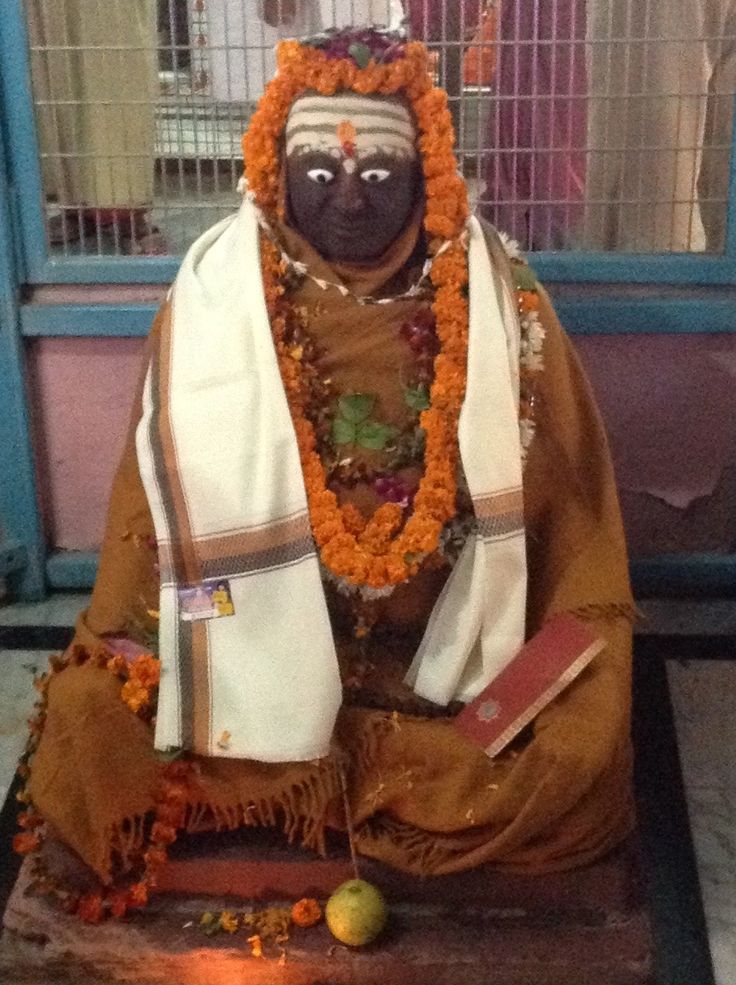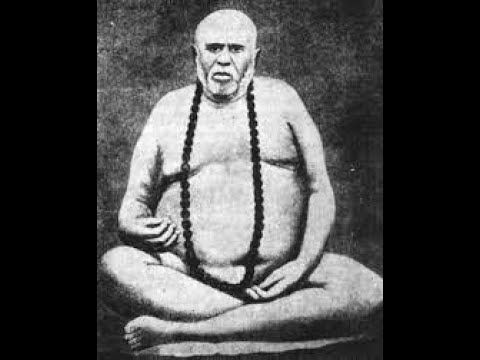Trailanga Swami Ashram in Varanasi
The Legacy of Trailanga Swami
Nestled among the holy banks of the Ganges, the Trailanga Swami Ashram has enthralled seekers for decades in Varanasi. This hallowed site is a living homage to Sri Trailanga Swami, a legendary Hindu yogi and mystic who permanently changed the spiritual terrain of India.
Often referred to as the “Walking Shiva of Varanasi,” Trailanga Swami was known for his extraordinary spiritual clarity and supernatural prowess. He is thought to have lived for more than three centuries and spent his last years in Varanasi, where he turned into a lighthouse of divine light for an unbounded number of devoted disciples.
The ashram bearing his name is a means of access to a deep spiritual enlightenment and meditation. Traveling from all around the world, visitors to this holy site seek a spiritual connection with the residual energy of the great saint and to have transcendental experiences within the busy holy city.
As we try to reveal the Trailanga Swami Ashram’s mysteries and wonders, we will look at its rich history, architectural importance, spiritual practices, and continuous impact on modern seekers. Come along as we remove the layers of time to expose the timeless knowledge emanating from this hallowed spiritual refuge.
The Life and Times of Trailanga Swami
Early Years and Spiritual Awakening
The saga of Trailanga Swami begins in the early 17th century in a small village called Kumbilapuram (now Kumili) in the Vizianagaram district of Andhra Pradesh. Born in 1607 as Shivarama to Narashingha Rao and Vidyavati Devi, the young boy showed signs of extraordinary spiritual inclination from an early age.
As Shivarama matured, his thirst for spiritual knowledge grew exponentially. He embarked on an intense journey of self-discovery, dedicating two decades to rigorous spiritual practices (sadhana). This period of intense introspection and discipline laid the foundation for the remarkable life that was to unfold.
The Transformative Encounter
In 1679, a pivotal moment occurred in Shivarama’s life when he encountered his spiritual preceptor, Bhagirathananda Saraswati, a sage from Punjab. This meeting marked a turning point, leading to Shivarama’s initiation into monastic life. In 1685, he received sannyasa (renunciation) vows and was bestowed with the name Swami Ganapati Saraswati.
Following his initiation, Swami Ganapati Saraswati intensified his spiritual practices, subjecting himself to severe austerities. His unwavering dedication to the path of yoga and meditation began to bear fruit, manifesting in the form of extraordinary spiritual powers and profound wisdom.
The Journey to Varanasi
The newly christened monk embarked on an extensive pilgrimage across India, visiting numerous holy sites and deepening his spiritual understanding. His travels eventually led him to Prayag (modern-day Allahabad) in 1733, where he spent several years in meditation and contemplation.
Finally, in 1737, Swami Ganapati Saraswati arrived in Varanasi, the city that would become his home for the next 150 years. It was here that he became known as Trailanga Swami, a name that would soon be whispered with reverence throughout the spiritual circles of India.

Life in the Holy City
In Varanasi, Trailanga Swami lived a life that defied conventional norms. He was often seen roaming the ghats and streets in a state of divine ecstasy, completely naked and seemingly oblivious to the material world around him. His presence in the city became a source of wonder and inspiration for both locals and pilgrims alike.
During his time in Varanasi, Trailanga Swami resided at various locations, including Assi Ghat, Vedavyas Ashrama at Hanuman Ghat, and Dashashwamedh Ghat. These places became focal points for spiritual seekers who were drawn to his magnetic presence and the aura of divinity that surrounded him.
Miraculous Feats and Spiritual Powers
Stories of Trailanga Swami’s miraculous abilities began to circulate widely. He was said to possess the power to cure illnesses, read minds, and even control the elements. Eyewitnesses reported seeing him float effortlessly on the waters of the Ganges for hours, seemingly defying the laws of physics.
One of the most famous accounts tells of Trailanga Swami lifting an enormous Shiva Lingam from the depths of the Ganges and installing it in his temple – a feat that would be impossible for any ordinary human. Such stories contributed to the growing belief that he was an incarnation of Lord Shiva himself.
Interactions with Contemporary Saints
During his long sojourn in Varanasi, Trailanga Swami crossed paths with numerous prominent spiritual figures of his time. Saints and seekers from various traditions sought his darshan (blessed sight) and guidance. Notable among these were Ramakrishna Paramahamsa, Swami Vivekananda, Lahiri Mahasaya, and many others who later went on to become renowned spiritual leaders in their own right.
These interactions served to further cement Trailanga Swami’s reputation as a living embodiment of the highest spiritual truths. His presence in Varanasi became a unifying force, bringing together diverse spiritual traditions under the umbrella of universal wisdom.
As we delve deeper into the life and legacy of this extraordinary being, we begin to understand the profound impact he had on the spiritual landscape of India and the world. The Trailanga Swami Ashram stands as a living monument to this impact, inviting seekers to experience the transformative power of his teachings and presence.
The Ashram: A Spiritual Haven
Location and Significance
The Trailanga Swami Ashram is strategically situated in the heart of Varanasi, approximately 1.7 kilometers east of the famous Kashi Vishwanath Temple. This location is not merely coincidental but holds deep spiritual significance. Positioned along the sacred Ganges, the ashram serves as a bridge between the physical and spiritual realms, much like its namesake who straddled both worlds with ease.
The ashram’s proximity to other important spiritual landmarks in Varanasi creates a powerful energy vortex. Pilgrims often include a visit to the ashram as part of their spiritual circuit in the holy city, recognizing it as a crucial point of connection to the divine.
Architectural Marvel
While modest in comparison to some of the grander temples in Varanasi, the Trailanga Swami Ashram possesses a unique architectural charm that reflects the simplicity and profound depth of its founder. The structure seamlessly blends elements of traditional North Indian temple architecture with more austere monastic design.
As visitors approach the ashram, they are greeted by a flight of stairs leading up from the ghat. These steps are not merely functional but serve as a metaphorical ascent towards higher consciousness. Along the walls of this staircase, one can spot small niches housing Shiva Lingams, each inviting a moment of reverence and reflection.
The Temple Complex
The heart of the ashram is its main temple, a space that exudes an atmosphere of deep tranquility and spiritual potency. The central chamber houses the massive Shiva Lingam that Trailanga Swami is said to have miraculously installed. This lingam serves as the primary focal point for worship and meditation within the ashram.
Surrounding the main sanctum are smaller shrines and meditation spaces, each dedicated to various aspects of spiritual practice. The walls are adorned with images and paintings depicting scenes from Trailanga Swami’s life, as well as representations of other saints and deities associated with the lineage.
The Samadhi Shrine
One of the most sacred spots within the ashram complex is the Samadhi shrine of Trailanga Swami. This underground chamber, located beneath the main temple, marks the spot where the great saint is said to have entered Mahasamadhi (the final conscious exit from the body). The energy in this space is palpable, with many visitors reporting profound meditative experiences and spiritual insights while sitting in silence here.
Meditation Spaces
Throughout the ashram, there are numerous nooks and corners designed for meditation and contemplation. These spaces range from small, individual alcoves to larger halls that can accommodate group practices. The design of these areas takes into account the principles of sacred geometry and energy flow, creating environments conducive to deep inner exploration.
The Ashram Library
For those seeking intellectual stimulation alongside spiritual practice, the ashram maintains a small but comprehensive library. Here, one can find texts on Advaita Vedanta, yoga philosophy, and the life and teachings of Trailanga Swami. The library also houses rare manuscripts and commentaries, making it a valuable resource for scholars and serious practitioners alike.
Natural Surroundings
While the ashram itself is a marvel, its setting adds another layer of spiritual ambiance. The proximity to the Ganges allows for easy access to the sacred waters, which play a crucial role in many rituals and practices conducted at the ashram. The sound of the flowing river, combined with the chanting of mantras and the ringing of temple bells, creates a symphony of spiritual vibrations that permeate the entire complex.
The ashram also maintains a small garden with medicinal plants and flowers used in various rituals. This green space serves as a peaceful retreat for visitors and residents alike, offering a connection to nature amidst the urban surroundings of Varanasi.
As we explore the physical aspects of the Trailanga Swami Ashram, it becomes clear that every element of its design and location is imbued with spiritual significance. The ashram stands not just as a monument to a great saint, but as a living, breathing space where the teachings and energy of Trailanga Swami continue to transform lives to this day.
Spiritual Practices and Rituals
Daily Worship and Aarti
The spiritual heartbeat of the Trailanga Swami Ashram pulses through its daily rituals and practices. At the core of these observances is the regular worship of the central Shiva Lingam, believed to have been installed by Trailanga Swami himself. This daily puja (worship) follows traditional Vedic protocols, involving the offering of flowers, incense, and sacred chants.
The highlight of the daily spiritual routine is the evening aarti, a ceremony of light and devotion. As the sun sets over the Ganges, the ashram comes alive with the melodious sounds of bells and devotional songs. Devotees gather to witness the priests perform elaborate rituals with lamps, creating a mesmerizing spectacle that serves to elevate the consciousness of all present.
Meditation and Yoga Sessions
True to the legacy of Trailanga Swami, the ashram places great emphasis on meditation and yoga as pathways to self-realization. Regular guided meditation sessions are conducted in the main hall, where practitioners can tap into the potent spiritual energy of the place. These sessions often incorporate techniques said to have been used by Trailanga Swami himself, including advanced pranayama (breath control) practices and contemplation on the nature of the Self.
Yoga classes, ranging from gentle Hatha to more intense Kundalini practices, are offered daily. These sessions are designed not just for physical well-being but as holistic tools for spiritual growth. The ashram’s approach to yoga is deeply rooted in the classical traditions, emphasizing the union of body, mind, and spirit.
Satsangs and Spiritual Discourses
The ashram regularly hosts satsangs (spiritual gatherings) where seekers can come together to discuss philosophical concepts, share experiences, and receive guidance from senior practitioners. These sessions often revolve around the teachings of Trailanga Swami and the principles of Advaita Vedanta, the non-dualistic philosophy that formed the cornerstone of his teachings.
Visiting scholars and spiritual leaders are frequently invited to give discourses on various aspects of Hindu philosophy and practice. These talks serve to deepen the understanding of both residents and visitors, creating a vibrant atmosphere of learning and spiritual inquiry.
Mantra Chanting and Japa
The power of sacred sound is harnessed through regular mantra chanting sessions. The ashram resonates with the vibrations of ancient Sanskrit mantras, particularly those associated with Lord Shiva and the lineage of Trailanga Swami. Devotees are encouraged to participate in these group chanting sessions and to maintain a personal practice of japa (repetition of mantras) using mala beads.
Seva (Selfless Service)
In keeping with the teachings of Trailanga Swami on the importance of selfless action, the ashram provides numerous opportunities for seva. Residents and visitors alike can participate in various service activities, from helping in the kitchen to maintaining the temple grounds. This practice of karma yoga is seen as an integral part of spiritual sadhana, helping to purify the mind and cultivate humility.
Spiritual Retreats and Intensive Programs
For those seeking a deeper immersion, the ashram offers periodic spiritual retreats and intensive programs. These can range from weekend workshops to month-long residential courses, covering a wide array of spiritual practices and philosophical studies. Participants in these programs often report transformative experiences, gaining new insights and spiritual breakthroughs.
Celebration of Sacred Festivals
The ashram comes alive during major Hindu festivals, particularly those associated with Lord Shiva such as Mahashivaratri. These celebrations involve elaborate pujas, all-night vigils, and special spiritual practices. The birth anniversary of Trailanga Swami is marked with great reverence, featuring special rituals and discourses on his life and teachings.
Annadanam (Offering of Food)
Following in the footsteps of Trailanga Swami, who was known for his compassion towards all beings, the ashram maintains a regular practice of annadanam. Free meals are offered to visitors and the needy, embodying the principle of seeing the divine in all and serving humanity as a form of worship.
Silent Retreats
Recognizing the power of silence in spiritual growth, the ashram periodically organizes silent retreats. During these times, participants maintain complete silence while engaging in intensive meditation and contemplation. These retreats are particularly popular among those seeking to deepen their practice and gain profound insights.
As we explore these various spiritual practices and rituals, it becomes evident that the Trailanga Swami Ashram is not just a place of historical significance, but a living center of spiritual transformation. Each practice, whether it’s the daily aarti or an intensive meditation retreat, is designed to help seekers connect with the timeless wisdom embodied by Trailanga Swami and to progress on their own path to self-realization.
Teachings and Philosophy
The Essence of Advaita Vedanta
At the core of Trailanga Swami’s teachings lies the profound philosophy of Advaita Vedanta, a non-dualistic interpretation of reality that posits the ultimate oneness of all existence. This ancient wisdom, which Trailanga Swami embodied and transmitted, forms the philosophical bedrock of the ashram’s spiritual practices.
Advaita Vedanta asserts that Brahman, the absolute reality, is the only truth, while the perceived world of multiplicity is ultimately an illusion (maya). According to this view, the individual self (atman) is not separate from Brahman but identical to it. The realization of this non-dual nature of reality is considered the highest spiritual attainment.
The ashram’s various programs and discourses delve deep into these concepts, helping seekers understand and experience this fundamental unity of existence. Through contemplation, meditation, and self-inquiry, practitioners are guided towards recognizing their true nature beyond the limitations of body and mind.
The Path of Jnana Yoga
Trailanga Swami was a master of Jnana Yoga, the path of knowledge and wisdom. This approach emphasizes intellectual discrimination and self-inquiry as means to spiritual liberation. The ashram continues this tradition by offering in-depth study of sacred texts like the Upanishads, Bhagavad Gita, and works of great Advaita masters.
Seekers are encouraged to cultivate viveka (discrimination between the real and unreal) and vairagya (dispassion towards worldly attachments). Through rigorous intellectual analysis and contemplation, they are guided to pierce through the veil of ignorance and recognize their true nature as pure consciousness.
The Integration of Bhakti and Karma
While Jnana Yoga forms the philosophical core, the teachings at the ashram also emphasize the importance of Bhakti (devotion) and Karma (action) in spiritual life. Trailanga Swami’s own life exemplified a perfect blend of these paths, demonstrating that realization of non-dual truth does not negate devotion or ethical action.
Devotional practices like puja, kirtan, and meditation on divine forms are seen as powerful tools to purify the mind and open the heart. Similarly, selfless service (seva) is encouraged as a means to transcend the ego and experience the interconnectedness of all beings.
The Four Qualifications (Sadhana Chatushtaya)
A key aspect of the spiritual curriculum at the ashram is the cultivation of the four qualifications deemed essential for spiritual progress in Advaita Vedanta:
- Viveka (Discrimination): The ability to discern between the eternal and the transient, the real and the unreal.
- Vairagya (Dispassion): Detachment from worldly pleasures and outcomes.
- Shatsampatti (Six Virtues): Comprising sama (mind control), dama (sense control), uparati (withdrawal), titiksha (endurance), shraddha (faith), and samadhana (concentration).
- Mumukshutva (Burning Desire for Liberation): An intense longing for spiritual freedom.
These qualifications are not seen as prerequisites but as ongoing practices to be cultivated throughout one’s spiritual journey. The ashram’s teachings and practices are designed to nurture these qualities in seekers.
The Concept of Jivanmukti
Trailanga Swami was considered a jivanmukta – one who has attained liberation while still in the body. This state of enlightenment, where one lives in the world but is not bound by it, is presented as the ultimate goal of spiritual practice.
The ashram’s teachings emphasize that jivanmukti is not a distant ideal but a living possibility. Through the integration of knowledge, devotion, and selfless action, seekers are guided towards realizing their inherent freedom and living from that realization in daily life.
The Power of Silence and Solitude
Drawing inspiration from Trailanga Swami’s own periods of silent contemplation, the ashram places great emphasis on the transformative power of silence and solitude. Regular periods of mauna (silence) are incorporated into the daily routine, and seekers are encouraged to cultivate inner stillness amidst activity.
The teachings highlight that true silence is not merely the absence of speech but a profound state of inner quietude where the fluctuations of the mind cease. This inner silence is seen as the doorway to deeper spiritual insights and experiences.
The Unity of All Paths
While rooted in Advaita Vedanta, the ashram’s teachings acknowledge the validity of various spiritual paths. Trailanga Swami himself was known to have interacted with and blessed seekers from diverse traditions. This spirit of inclusivity is reflected in the ashram’s approach, which recognizes that different individuals may resonate with different practices while all ultimately leading to the same truth.
Practical Application in Daily Life
A unique aspect of the teachings at Trailanga Swami Ashram is the emphasis on practical application. Seekers are encouraged to view every aspect of daily life as an opportunity for spiritual practice. Whether it’s eating, working, or interacting with others, each activity is seen as a potential gateway to deeper awareness and self-realization.
The ashram offers guidance on how to integrate spiritual principles into modern life, addressing contemporary challenges through the lens of timeless wisdom. This practical approach ensures that the teachings remain relevant and transformative for seekers from all walks of life.
As we delve into the rich tapestry of teachings and philosophy at the Trailanga Swami Ashram, we see a comprehensive spiritual system that addresses all aspects of human existence. From the loftiest metaphysical concepts to the most practical aspects of daily living, the ashram provides a holistic framework for spiritual growth and self-realization, continuing the legacy of its illustrious founder.
Notable Visitors and Disciples
Spiritual Luminaries
The Trailanga Swami Ashram has been a magnet for spiritual seekers and luminaries since its inception. One of the most renowned visitors was Sri Ramakrishna Paramahamsa, the great 19th-century mystic. During his visit to Varanasi, Ramakrishna sought out Trailanga Swami, recognizing him as a living embodiment of Lord Shiva. Their meeting was said to be a profound exchange of spiritual energy, with Ramakrishna later describing Trailanga Swami as a true “knower of Brahman.”
Swami Vivekananda, Ramakrishna’s foremost disciple and a key figure in introducing Vedanta to the West, also visited the ashram during his travels. He was deeply impressed by Trailanga Swami’s spiritual stature and spoke highly of him in his lectures and writings.
Other notable visitors included Lahiri Mahasaya, the famed Kriya Yoga master, and Swami Bhaskarananda Saraswati, another revered saint of Varanasi. These encounters served to further cement the ashram’s reputation as a powerhouse of spiritual energy.
Disciples and Lineage Holders
While Trailanga Swami was known for his solitary nature, he did accept a select few disciples who carried forward his teachings. Among these was Umacharan Mukhopadhyay, who became one of his closest confidants and documented many of the saint’s teachings and miraculous deeds.
Another significant disciple was Shankari Mai Jiew, a female ascetic who received training from Trailanga Swami from her childhood. She went on to become a respected spiritual figure in her own right, known for her austere practices in the Himalayas.
The lineage of Trailanga Swami, while not as formally structured as some other spiritual traditions, continues through those who have been deeply influenced by his life and teachings. Many contemporary spiritual teachers trace their spiritual ancestry back to Trailanga Swami, either through direct lineage or inspirational connection.
Contemporary Spiritual Leaders
In more recent times, the ashram has hosted visits from various contemporary spiritual leaders and teachers. These have included heads of major Hindu monastic orders, internationally renowned yoga teachers, and scholars of Vedanta philosophy.
Such visits often coincide with special events or festivals at the ashram, providing residents and visitors with opportunities to interact with a diverse range of spiritual perspectives, all united in their reverence for Trailanga Swami’s legacy.
International Seekers
The fame of Trailanga Swami and the spiritual potency of the ashram have attracted seekers from across the globe. Many international visitors have reported profound experiences during their stay, with some going on to become dedicated practitioners of the teachings imparted here.
Notable among these international disciples are several Western scholars and practitioners who have played crucial roles in translating and disseminating the teachings of Trailanga Swami to a global audience. Their work has helped to bridge cultural and linguistic gaps, making these profound spiritual insights accessible to a wider audience.
Artists and Intellectuals
The ashram has also been a source of inspiration for various artists, writers, and intellectuals over the years. Many have come seeking creative inspiration or deeper insights into Indian spirituality. The serene atmosphere and rich spiritual heritage of the place have often served as catalysts for artistic and intellectual breakthroughs.
Political and Social Leaders
While primarily a spiritual center, the ashram has occasionally hosted visits from political and social leaders seeking blessings or spiritual guidance. These visits, while not publicized, have sometimes led to interesting intersections of spiritual wisdom and social action.
The Continuing Legacy
Today, the Trailanga Swami Ashram continues to attract a diverse array of visitors, from serious spiritual aspirants to curious tourists. Each person who enters its premises becomes part of its ongoing story, contributing to the vibrant tapestry of spiritual seeking that has characterized this sacred space for generations.
The ashram maintains a visitor’s book where many have recorded their experiences and insights. These testimonials serve as a living document of the ashram’s impact on countless lives, spanning cultures, generations, and spiritual backgrounds.
As we reflect on the notable visitors and disciples associated with the Trailanga Swami Ashram, we see a rich lineage of spiritual transmission. From revered saints to ordinary seekers, each has played a role in keeping alive the flame of wisdom ignited by Trailanga Swami. This continuous flow of seekers and sages ensures that the ashram remains not just a historical site, but a living, breathing center of spiritual transformation.
Miracles and Mystical Phenomena
The Floating Sage
One of the most widely recounted miracles associated with Trailanga Swami is his ability to float or walk on the surface of the Ganges. Numerous eyewitnesses, including respected figures of the time, reported seeing the sage effortlessly gliding on the river’s surface, sometimes for hours on end. This demonstration of mastery over the elements was seen as a clear sign of his advanced yogic powers.
Some accounts describe how Trailanga Swami would meditate while submerged in the Ganges for extended periods, emerging completely dry. These feats not only astounded onlookers but also served as powerful teachings on the illusory nature of physical laws when viewed from the perspective of higher consciousness.
The Immovable Yogi
Another famous incident involves Trailanga Swami’s encounter with British authorities during colonial rule. When soldiers attempted to move him from his meditation spot, they found him impossibly heavy, as if rooted to the ground. No amount of force could budge the sage, demonstrating his yogic ability to alter his body’s physical properties at will.
This event, witnessed by many, became a symbol of spiritual power transcending worldly authority and served as an inspiration for many Indians during a time of colonial oppression.
Healing Touch
Numerous stories circulate about Trailanga Swami’s ability to heal the sick and afflicted through mere touch or blessing. People from all walks of life, including those with supposedly incurable ailments, sought his intervention. Many reported miraculous recoveries after receiving his darshan (blessed sight) or touch.
One particularly famous account tells of a leper who was completely cured after Trailanga Swami allowed him to drink the water used to wash his (Trailanga Swami’s) feet. Such acts of compassion and healing power further cemented his reputation as a living embodiment of the divine.
Bilocation and Omnipresence
Some devotees claimed to have experienced Trailanga Swami’s presence in multiple places simultaneously. These accounts of bilocation or apparent omnipresence added to the mystique surrounding the sage. People reported receiving his guidance or blessings in dreams or visions, even when physically distant from him.
These experiences were interpreted as demonstrations of the limitless nature of consciousness, transcending the usual boundaries of time and space – a central tenet in advanced yogic and Vedantic philosophy.
The Shiva Lingam Miracle
Perhaps one of the most tangible miracles associated with Trailanga Swami is the massive Shiva Lingam installed in the main temple of the ashram. According to legend, Trailanga Swami single-handedly lifted this enormous stone from the depths of the Ganges and placed it in the temple.
The sheer size and weight of the lingam make such a feat seemingly impossible by normal human standards. This lingam continues to be a focal point of worship and wonder at the ashram, serving as a physical reminder of Trailanga Swami’s extraordinary powers.
Ageless Appearance
Despite claims of his extremely advanced age (some accounts suggest he lived for over 300 years), those who encountered Trailanga Swami often remarked on his youthful appearance and vitality. This apparent mastery over the aging process was seen as evidence of his yogic accomplishments and control over the physical body.
Prophecies and Clairvoyance
Many devotees reported instances of Trailanga Swami’s clairvoyant abilities. He was said to be able to read minds, predict future events, and offer insights into people’s past lives. These demonstrations of supernatural knowledge often led to profound transformations in those who experienced them.
The Python State (Ajagaravritti)
In his later years, Trailanga Swami was known to enter a state called Ajagaravritti, or the “python state.” In this condition, he would remain completely still, accepting food and water only when offered, much like a python that moves only to accept food. This state, lasting for extended periods, was seen as a demonstration of complete transcendence of bodily needs and desires.
Continued Phenomena at the Ashram
Even after Trailanga Swami’s physical departure, the ashram continues to be a site of reported mystical phenomena. Visitors often speak of unexplainable experiences, from spontaneous healings to visions of the sage himself. Many report entering into deep meditative states effortlessly while in the premises, especially in the Samadhi shrine.
Some devotees claim to have received guidance or blessings from Trailanga Swami in dreams or meditations, reinforcing the belief that his spiritual presence continues to pervade the ashram.
Scientific Investigations
In recent years, there have been attempts to scientifically investigate some of the ongoing phenomena at the ashram. Researchers have conducted studies on the electromagnetic fields in key areas of the complex, the chemical composition of the vibhuti (sacred ash) that sometimes manifests spontaneously, and the altered states of consciousness reported by meditators.
While these investigations are ongoing and inconclusive, they represent an interesting intersection of ancient spiritual traditions with modern scientific inquiry.
The Purpose of Miracles
It’s important to note that in the tradition of Trailanga Swami and the teachings of the ashram, miracles are not seen as ends in themselves. Rather, they are viewed as side effects of spiritual realization or as tools to awaken faith and spiritual aspiration in seekers.
The ashram’s teachings emphasize that the greatest miracle is the transformation of consciousness from ignorance to self-realization. All other phenomena, however extraordinary, are considered secondary to this ultimate goal.
As we explore these accounts of miracles and mystical phenomena associated with Trailanga Swami and his ashram, we are reminded of the vast potential that lies within human consciousness. These stories serve not just as fascinating tales, but as invitations to explore the deeper dimensions of our own being, inspiring us to look beyond the apparent limitations of the physical world and connect with the infinite possibilities of the spirit.
The Ashram Today: A Living Legacy
Preserving Tradition in Modern Times
In the bustling heart of Varanasi, the Trailanga Swami Ashram stands as a beacon of timeless wisdom, seamlessly blending ancient traditions with contemporary relevance. The ashram’s management has undertaken the delicate task of preserving the essence of Trailanga Swami’s teachings while adapting to the needs of modern seekers.
The daily routines and core practices established by Trailanga Swami continue to form the backbone of ashram life. However, these have been complemented by new initiatives designed to make the teachings more accessible to a diverse, global audience. For instance, the ashram now offers online courses and live-streamed satsangs, allowing devotees from around the world to connect with its spiritual energy.
Restoration and Expansion
Recent years have seen careful restoration work carried out on the ashram’s historic structures. This process has been guided by a commitment to maintain the authentic spiritual atmosphere while ensuring the safety and comfort of visitors. New meditation halls and accommodation facilities have been added, allowing for increased capacity without compromising the serene environment.
The ashram has also expanded its environmental initiatives, implementing sustainable practices such as solar power, rainwater harvesting, and organic gardening. These efforts reflect a holistic approach to spirituality that honors the interconnectedness of all life.
Educational and Outreach Programs
Recognizing the need for spiritual education in today’s world, the ashram has developed a comprehensive curriculum that covers various aspects of yoga, meditation, and Vedantic philosophy. Regular workshops, retreats, and teacher training programs attract participants from diverse backgrounds, fostering a global community of practitioners.
The ashram has also established partnerships with universities and research institutions, facilitating studies on the effects of meditation and yogic practices on physical and mental health. These collaborations help bridge the gap between ancient wisdom and modern science, validating the relevance of these practices in contemporary life.
Cultural and Artistic Initiatives
Embracing Trailanga Swami’s legacy as a source of inspiration for artists and intellectuals, the ashram now hosts regular cultural events. These include music concerts, dance performances, and art exhibitions that explore spiritual themes. An artist-in-residence program allows creative individuals to immerse themselves in the ashram’s atmosphere, producing works that interpret spiritual concepts for modern audiences.
Social Service and Community Engagement
Staying true to Trailanga Swami’s compassionate nature, the ashram has expanded its social service activities. Free medical camps, educational support for underprivileged children, and vocational training programs for local youth are some of the initiatives undertaken. These efforts extend the ashram’s spiritual mission into practical realms, embodying the principle of seeing divinity in all beings.
Digital Presence and Global Reach
Embracing technology as a tool for spiritual dissemination, the ashram has developed a strong online presence. A comprehensive website offers resources on Trailanga Swami’s teachings, virtual tours of the ashram, and online courses. Social media platforms are utilized to share daily inspirational messages and live-stream important events, connecting a global community of followers.
Interfaith Dialogue and Harmony
Recognizing the universal nature of spiritual truth, the ashram has become a center for interfaith dialogue. Regular symposiums bring together representatives from various religious traditions to explore common ground and promote mutual understanding. This initiative reflects Trailanga Swami’s inclusive
Buy my book – Click Here







